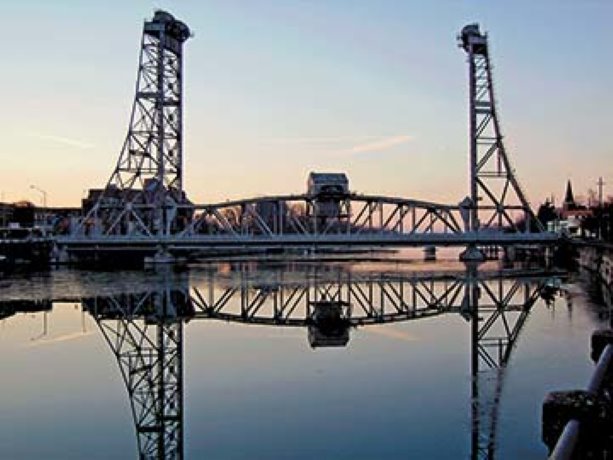The Welland Main Street Bridge has become an icon of the city of Welland, Ont, instantly recognizable as part of its identity. Designated a historic structure by Heritage Welland, it’s no wonder that Niagara Region, the bridge owner, is lavishing the steel structure with $5.8 million worth of attention.
Although it was designed as a vertical lift bridge crossing an older alignment of the Welland Canal, its lifts are currently non-functional. Almost 11,000 vehicles per day use the bridge to cross what is now the Welland Recreational Waterway.
Known officially as Bridge 13, the structure was built by the Dominion Bridge Company between 1927 and 1930 on a budget of $986,000. All of the “high steel” was erected by ironworkers recruited from the Mohawk First Nation. Concrete work was sub-contracted to the firm of Maguire, Cameron and Phin. The finished bridge runs 232 feet long and 30 feet wide and the twin lift towers on either end rise to 170 feet. An operator’s house sits suspended at the bridge’s centre.
Welland historian Terry Hughes notes that the concrete counterbalances once located on the lift towers weighed 500 tons each.
“The bridge was operated by electric motors which could raise it in 90 seconds,” he says. “A back-up gasoline engine could raise it inside of two minutes. They used to have crews who would chip away at any loose concrete on the counterbalances when the bridge was in the raised position.”
Hughes notes that the bridge is set at a 22 degree skew to the waterway, a nod to early 20th century engineering aesthetics. The canal doesn’t run perpendicular to Main Street and it was considered more important to align the bridge to the road than to the canal.
The canal was rerouted with the construction of the Welland By-Pass and the Main Street Bridge was officially raised and lowered for the last time on Dec. 15, 1972 for a ship named the Georgian Bay.
“It was unofficially raised and lowered one last time for a smaller service ship the next day,” says Hughes.
The bridge was last rehabilitated in 2005 in a $3-million project that included concrete repairs, removal of steel splash guards, below-deck structural repairs and recoating of structural steel to 1.8 metres above the roadway.
Associated Engineering of St. Catharines is the consultant for the current round of bridge rehabilitation expected to extend from April to August of this year. A bridge inspection was carried out in the fall of 2013 according to Ontario Structure Inspection Manual guidelines. The report noted delamination of some concrete, and deteriorated and corroded steel surfaces. In some small sections of the bridge, steel loss approaches 100 per cent. In a few cases structural steel elements have been damaged by vehicle impact — probably snow plows.
Under the contract, damaged and corroded steel plates, angles and braces will be replaced and repaired and the control house structure will be upgraded using a new cladding system. However, the lion’s share of the budget — about $4 million — will go to stripping the steel to bare metal and recoating it with a three-part epoxy.
“The last round of bridge rehabilitation only painted part of the bridge,” says Geoff Burn, project manager with Associated Engineering. “However, the rest of the bridge is still coated with lead paint. We’ll be taking it down to the metal, but that will mean enclosing the entire bridge in a negative pressure system to eliminate the potential of contaminants being released into the air and water.”
Various stakeholders have floated the notion that the bridge would cost less to maintain if its signature towers were removed. However public sentiment and the Welland Downtown Business Improvement Area continue to favour historical preservation.
Hughes likens the removal of the towers to demolishing the Tower of Pisa because the building is damaged.
“I’ve often thought that the bridge could bring in some revenue by renting space on the towers for telecommunications antennas,” he says.
Mike DiPaola, associate director of transportation engineering for Niagara Region, estimates that the current project will extend the life of the bridge — and its towers — for another 15 to 25 years.



Recent Comments
comments for this post are closed